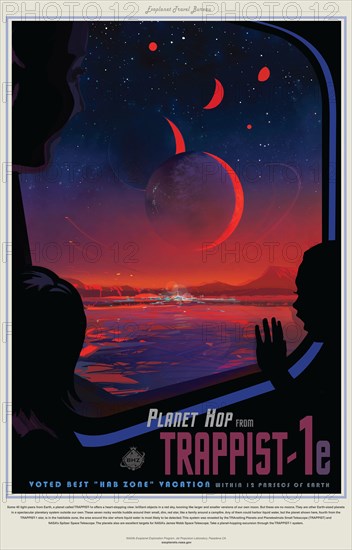Sujet
A NASA poster promoting the discovery of planets that possible could support life. Some 40 light-years from Earth, a planet called TRAPPIST-1e offers a heart-stopping view: brilliant objects in a red sky, looming like larger and smaller versions of our own moon. But these are no moons. They are other Earth-sized planets in a spectacular planetary system outside our own. These seven rocky worlds huddle around their small, dim, red star, like a family around a campfire. Any of them could harbor liquid water, but the planet shown here, fourth from the TRAPPIST-1 star, is in the habitable zone, th
Légende
A NASA poster promoting the discovery of planets that possible could support life. Some 40 light-years from Earth, a planet called TRAPPIST-1e offers a heart-stopping view: brilliant objects in a red sky, looming like larger and smaller versions of our own moon. But these are no moons. They are other Earth-sized planets in a spectacular planetary system outside our own. These seven rocky worlds huddle around their small, dim, red star, like a family around a campfire. Any of them could harbor liquid water, but the planet shown here, fourth from the TRAPPIST-1 star, is in the habitable zone, the area around the star where liquid water is most likely to be detected. This system was revealed by the TRansiting Planets and PlanetIsmals Small Telescope (TRAPPIST) and NASA's Spitzer Space Telescope. The planets are also excellent targets for NASA's James Webb Space Telescope.
Info+
Photographe : Frances Roberts
Date
17 févr. 2017
Crédit
Photo12/Alamy/Frances Roberts
Notre référence
LMY21T02_HREKAG
Utilisation
uniquement en France
Model release
Non
Property release
Non
Licence
Droits gérés
Format disponible
61,9Mo (1,1Mo) / 31,5cm x 49,2cm / 3726 x 5810 (300dpi)
